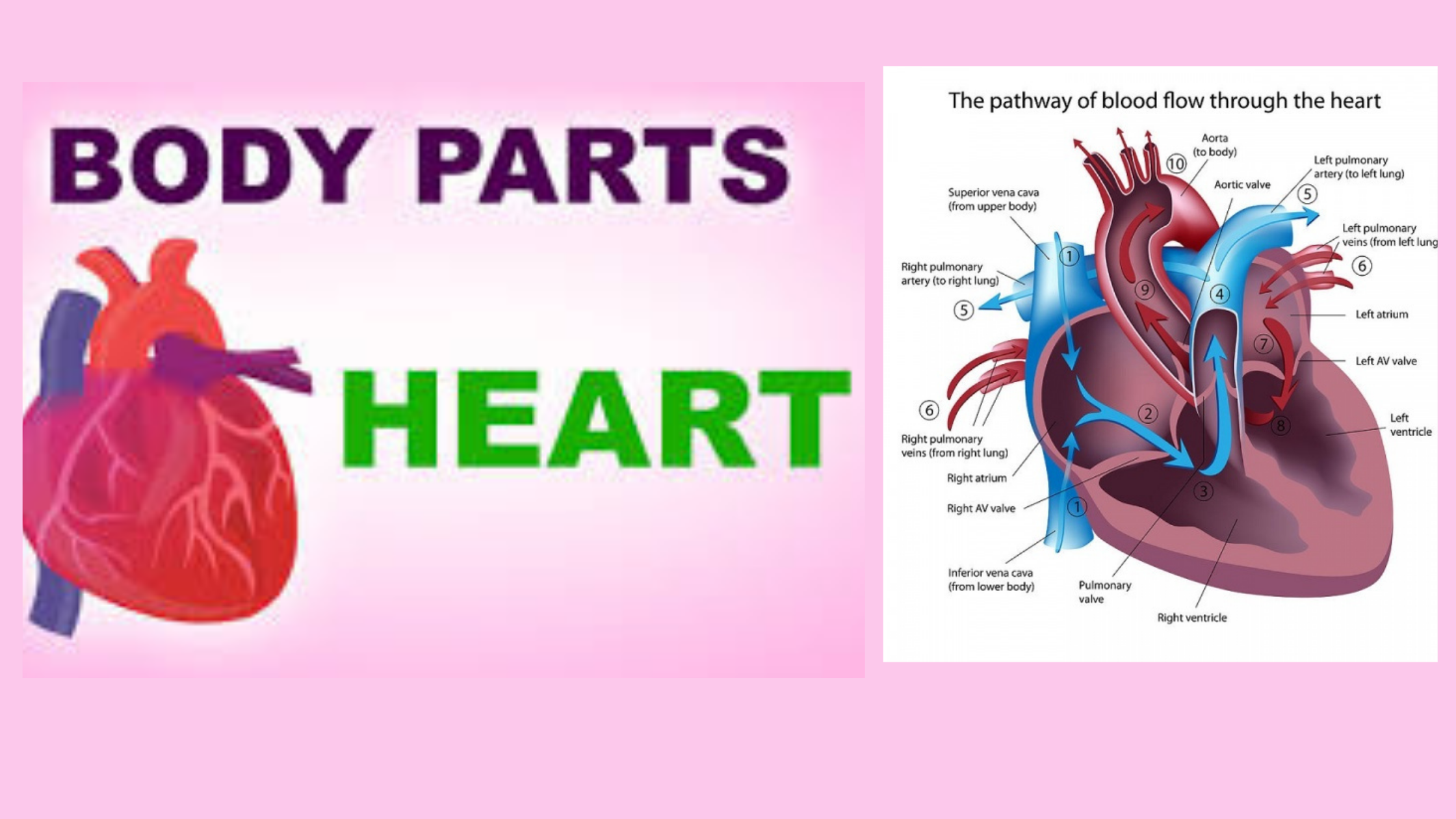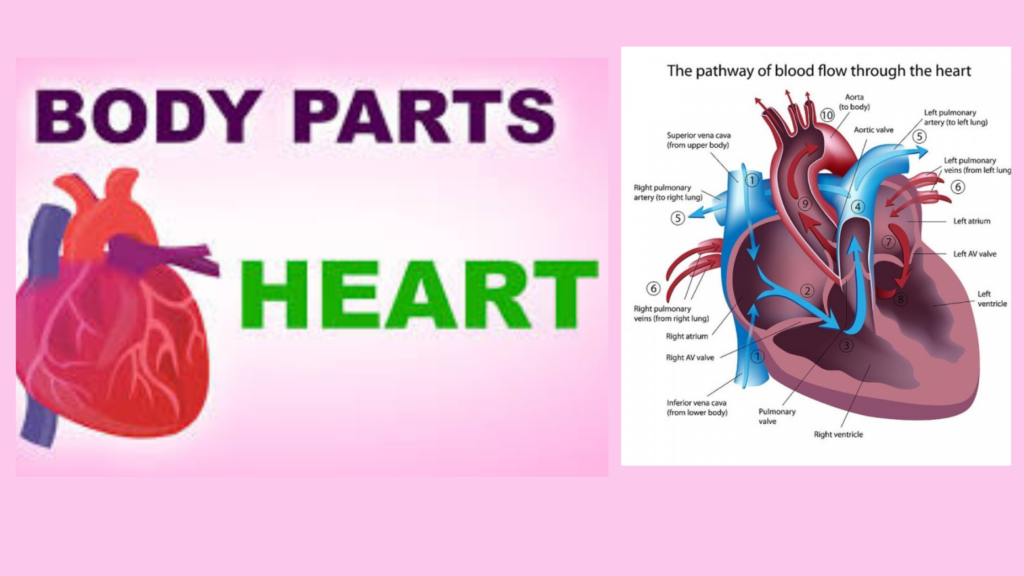
how does blood flow through the heart step by step
The human heart is a highly tuned instrument that provides service to the entire body. It’s a muscular organ about the size of a closed fist that rests slightly to the left of center in the chest.
The heart beats 100,000 times every day, moving roughly 8 pints of blood throughout the body 24 hours a day, seven days a week. This transports waste and provides oxygen and nutrient-rich blood to tissues and organs.
The heart pumps deoxygenated blood to the lungs, where it picks up oxygen and releases carbon dioxide, a metabolic waste product.
The circulatory system is made up of the heart, blood, and blood vessels (arteries, capillaries, and veins).
The anatomy of the heart, how it pumps blood around the body, and the electrical system that controls it are all covered in this page.
The heart is made up of two pumps, one on the right and one on the left, that function in tandem. The right atrium pumps blood to the right ventricle, which then pumps it to the lungs, where it receives oxygen. Blood travels from the lungs to the left atrium and subsequently to the left ventricle. Your heart’s job is to pump enough blood to keep the brain and other critical organs supplied with oxygen and nutrients on a continual basis.

How the Heart Functions
Your circulatory system, which is a network of blood vessels that supplies blood to every area of your body, is centered on your heart. Blood transports oxygen and other vital nutrients to all human organs, ensuring that they remain healthy and function correctly.
The role of your heart, which is a muscle, is to pump blood throughout your circulatory system.
What mechanism does my heart use to pump blood?What is the function and structure of the heart?
The right side and the left side of your heart have distinct pumping mechanisms.
The right side of your heart takes oxygen-depleted blood from your veins and pumps it to your lungs, where it picks up oxygen and expels carbon dioxide.
The left side of your heart takes oxygen-rich blood from your lungs and pumps it to the rest of your body through your arteries.
Your heart is divided into four chambers, two on the right side and two on the left, that pump blood.
What is the flow of blood through the heart like?
Blood travels in four stages through your heart and lungs:
1. The right atrium takes oxygen-depleted blood from the body and pumps it through the tricuspid valve to the right ventricle.
2. Through the pulmonary valve, the right ventricle sends oxygen-poor blood to the lungs.
3. Through the mitral valve, the left atrium gets oxygen-rich blood from the lungs and pumps it to the left ventricle.
4. The oxygen-rich blood is pumped from the left ventricle to the remainder of the body via the aortic valve.
The atria, which are smaller chambers that pump blood into the ventricles, are located on the left and right sides of the heart. Pumps in the left and right ventricles are more powerful. Because it needs to pump blood throughout the body, the left ventricle is the most powerful. All four chambers of your heart work together in a constant and coordinated effort to keep oxygen-rich blood flowing throughout your body when it operates correctly. Your heart has its own electrical system that governs the frequency of beats and coordinates the functioning of the heart chambers (heart rhythm) (heart rate).
How does my heart continue to operate normally?
Your heart’s job is to pump enough blood to keep the brain and other critical organs supplied with oxygen and nutrients on a continual basis. To do this, your heart must:
Control the rate at which your heart beats. The electrical circuitry of your heart regulates the pump’s timing. The electrical system regulates the rate at which your heart beats and keeps it in a regular rhythm. When the electrical system is functioning properly, the heart rate and rhythm remain normal. An arrhythmia occurs when your heart chambers beat in an uncoordinated or random manner, or when your heart beats excessively rapidly (tachycardia) or too slowly (bradycardia) (bradycardia).
Maintain the health of your heart muscle. Myocardium is a kind of muscle that makes up the four chambers of your heart. The major pumping work is done by the myocardium: It relaxes to allow blood to flow into it, then squeezes (contracts) to force the blood out. The term “contractility” refers to how effectively the heart muscle contracts. Your heart rests and fills with blood after pounding. Before it pumps again, the muscle must be allowed to relax sufficiently to adequately fill with blood. Your heart muscle’s contractility and capacity to relax are both affected by its health, and both impact whether your heart can pump enough blood each time it beats.
Difficulties with heart muscle contractility can be caused by problems with the muscle itself (such as a viral infection or a hereditary heart muscle disease) or problems with the heart muscle’s blood supply (such as reduced blood flow to the heart muscle, called ischemia). Because your heart muscle, like the rest of your body, need oxygen and other nutrients to be healthy, it requires its own blood supply. As a result, your heart uses your coronary arteries to pump oxygen-rich blood to its own muscle.
Maintain a healthy blood flow. The movement of blood in and out of the chambers of your heart is controlled by four valves. On either side of your heart, there are valves that connect the atrium and the ventricle. The flow of blood out of each of your ventricles is likewise controlled by a valve. The valves are solely meant to allow blood to flow forward. A valve opens when each chamber contracts, allowing blood to flow out. The valve shuts as the chamber relaxes, preventing blood from escaping back into the chamber and allowing the chamber to refill with blood. A issue with your heart valves can cause difficulties for your heart by disrupting the regular flow of blood.
Do you know What is hart attact
A heart attack occurs when blood supply to a portion of your heart muscle is suddenly cut off. It’s a common misconception that a heart attack would result in you collapsing, but this isn’t always the case. The animation describes what a heart attack is, how to treat it, and how to decrease the chance of having another heart attack by making lifestyle changes.
How do you know if you’re having a heart attack?
Heart attack symptoms vary, however the following are the most typical ones:
A sudden onset of chest pain or discomfort that does not go away. In your chest, you may feel pressure, squeezing, or heaviness. It may feel as if you have indigestion or are experiencing a burning feeling.
The discomfort may migrate to your left or right arm, as well as your neck, jaw, back, or stomach.
feeling nauseous, hot, light-headed, or out of breath
Other symptoms that are less prevalent include:
Anxiety that comes on suddenly, akin to a panic attack
A buildup of fluid in the lungs causes frequent coughing or wheezing.
The intensity of pain varies from person to person. Some patients have significant pain or stiffness in their chests, while others only experience discomfort or pain that is comparable to indigestion.
Symptoms of a heart attack might last for days or appear abruptly and unexpectedly.
What are the variations between men and women’s heart attack symptoms?
Men and women have distinct symptoms when they have a heart attack, according to popular belief. While individual symptoms differ, there are no symptoms that women suffer more or less frequently than males.
Women are more prone than males to reject the possibility of a heart attack and postpone seeking medical help. To avoid injuring the heart muscle, it’s critical to recognize the signs of a heart attack, take them seriously, and act immediately.
Women’s heart attack signs and symptoms
The signs and symptoms of a heart attack vary from person to person, however the following are the most common:
Chest pain or discomfort that appears out of nowhere and does not go away. It might feel like squeezing, tightness, or pressure.
It’s possible that the discomfort will extend to your left or right arm, as well as your neck, jaw, back, or stomach.
You may also experience nausea, sweating, light-headedness, or shortness of breath.
Other symptoms that are less prevalent include:
Anxiety that comes on suddenly, akin to a panic attack
Women’s heart attack signs and symptoms
The signs and symptoms of a heart attack vary from person to person, however the following are the most common:
Chest pain or discomfort that appears out of nowhere and does not go away. It might feel like squeezing, tightness, or pressure.
It’s possible that the discomfort will extend to your left or right arm, as well as your neck, jaw, back, or stomach.
You may also experience nausea, sweating, light-headedness, or shortness of breath.
Other symptoms that are less prevalent include:
Anxiety that comes on suddenly, akin to a panic attack
Women’s heart attack signs and symptoms
The signs and symptoms of a heart attack vary from person to person, however the following are the most common:
Chest pain or discomfort that appears out of nowhere and does not go away. It might feel like squeezing, tightness, or pressure.
It’s possible that the discomfort will extend to your left or right arm, as well as your neck, jaw, back, or stomach.
You may also experience nausea, sweating, light-headedness, or shortness of breath.
Other symptoms that are less prevalent include:
Anxiety that comes on suddenly, akin to a panic attack
Coughing or wheezing in excess
If you suspect you’re suffering a heart attack, dial 999 to get an ambulance.
Despite the warning signals, women may be less inclined to seek medical care and treatment. This can significantly lower your chances of surviving.
The goal of therapy is to restore blood flow to the damaged portion of the heart muscle as quickly as feasible. This helps to keep the damage to the heart to a minimum.
What can I do to reduce my chances of developing heart disease?
1.Fortunately, there are a number of things you may do to lower your risk of heart disease:
Maintain a healthy blood pressure level. Heart disease is caused by high blood pressure, which is a key risk factor. It’s critical to have your blood pressure tested on a regular basis – at least once a year for most individuals, and much more frequently if you have high blood pressure. Take efforts to avoid or control high blood pressure, including making lifestyle changes.
2.Maintain a healthy cholesterol and triglyceride level. Cholesterol levels that are too high can block arteries, increasing your risk of coronary artery disease and heart stroke. Cholesterol can be reduced by a combination of lifestyle modifications and medications (if necessary). Triglycerides are a kind of fat found in the bloodstream. High triglyceride levels can also increase the risk of coronary heart disease, particularly in women.
3.Maintain a healthy body weight. Obesity or being overweight might raise your risk of heart disease. This is mostly due to their association with other heart disease risk factors such as high blood cholesterol and triglyceride levels, high blood pressure, and diabetes. These dangers can be reduced if you maintain a healthy weight.
4.Maintain a balanced diet. Limit saturated fats, high-sodium meals, and added sweets. Consume a variety of fruits, veggies, and whole grains. The DASH diet is an example of an eating plan that can help you lower your blood pressure and cholesterol, two factors that can reduce your heart disease risk.
5.Get some exercise on a regular basis. Exercise offers several advantages, including strengthening the heart and increasing circulation. It can also aid in the maintenance of a healthy weight as well as the reduction of cholesterol and blood pressure. All of these things can help you avoid heart disease.
6.Alcohol should be consumed in moderation. Too much alcohol might cause your blood pressure to rise. It also adds more calories, perhaps leading to weight gain. Both of these factors increase your chances of developing heart disease. Men should limit themselves to two alcoholic drinks each day, while women should limit themselves to one.
7.Please don’t smoke. Cigarette smoking elevates blood pressure and increases your risk of heart attack and stroke. Don’t start smoking if you don’t already. If you smoke, stopping reduces your chances of developing heart disease. You can get assistance from your health care practitioner in determining the best method for you to quit.
8.Take care of your tension. In many ways, stress is connected to heart disease. It has the potential to increase your blood pressure. A heart attack can be triggered by extreme stress. Furthermore, several popular stress-relieving behaviors, such as overeating, heavy drinking, and smoking, are harmful to your heart. Exercising, listening to music, focusing on something quiet or serene, and meditating are all good methods to handle stress.
9.Take care of your tension. In many ways, stress is connected to heart disease. It has the potential to increase your blood pressure. A heart attack can be triggered by extreme stress. Furthermore, several popular stress-relieving behaviors, such as overeating, heavy drinking, and smoking, are harmful to your heart. Exercising, listening to music, focusing on something quiet or serene, and meditating are all good methods to handle stress.
10.Take care of your diabetes. Diabetic heart disease is two times more likely if you have diabetes. Diabetes causes high blood sugar, which damages your blood vessels and the nerves that control your heart and blood vessels over time. As a result, it’s critical to get tested for diabetes and, if diagnosed, to keep it under control.
11.Make certain you get adequate rest. You increase your chances of high blood pressure, obesity, and diabetes if you don’t get enough sleep. These three factors might increase your chances of developing heart disease. The average adult need 7 to 9 hours of sleep every night. Make sure you’re getting enough sleep. If you’re having trouble sleeping, make an appointment with your doctor. Sleep apnea is a condition that causes people to cease breathing for small periods of time while sleeping. This makes it difficult to obtain a decent night’s sleep and increases your risk of heart disease. If you suspect you have it, speak with your doctor about getting a sleep study. Also, if you do have sleep apnea, make sure you get it treated.
Preventing Heart Attacks Through Lifestyle Changes
A lack of dedication to a heart-healthy lifestyle is one of the leading causes of these figures. Your lifestyle is both your best protection and your duty in the fight against heart disease and stroke. The following suggestions are part of a heart-healthy lifestyle. All modifiable risk factors for heart disease, heart attack, and stroke can be reduced by following these easy measures.
Quit smoking.
Quit smoking if you’re a smoker. Encourage everyone who smokes in your home to give up. We understand how difficult it is. However, recovering from a heart attack or stroke, as well as living with chronic heart disease, is more difficult. Make the decision to stop smoking. If you want assistance, we are here to assist you.
Choose healthy eating habits.
One of the most effective weapons in the battle against cardiovascular disease is a healthy diet. Other controllable risk factors, including as cholesterol, blood pressure, diabetes, and obesity, can be influenced by the food you consume (and how much of it you eat). Choose nutrient-rich foods over nutrient-poor meals, which are high in vitamins, minerals, fiber, and other nutrients but low in calories. Choose a diet rich in fruits, vegetables, and whole grains, as well as low-fat dairy products, chicken, and fish.
Limit your diet of sweets, sugar-sweetened drinks, and red meats while increasing your intake of legumes, nontropical vegetable oils, and nuts. Also, to maintain a healthy weight, make sure your food and physical activity levels are in sync so you’re burning as many calories as you’re consuming.
High cholesterol levels in the blood
A buildup of fat in your arteries is a recipe for catastrophe. It may cause a heart attack or stroke at some point in the future. Reduce your saturated fat, trans fat, and cholesterol intake, and get some exercise. If diet and exercise alone aren’t enough to lower those levels, medication may be the answer. Take it exactly as directed by the doctor. Here’s how to figure out where those numbers should be:
Cholesterol Total
The following calculation is used to determine your total cholesterol score: HDL + LDL + 20% of your triglyceride level.
LDL cholesterol (low-density lipoprotein) is “bad” cholesterol. A low LDL cholesterol level is thought to be beneficial to heart health. According to the newest guidelines from the American Heart Association, your LDL score should no longer be the primary determinant in directing treatment to avoid heart attack and stroke. The guidelines state that individuals using statins are no longer required to lower their LDL cholesterol levels to a specified target level. LDL cholesterol can be raised by lifestyle factors such as a diet heavy in saturated and transfats.
HDL cholesterol (high-density lipoprotein) = “good” cholesterol
Higher levels of HDL (good) cholesterol are usually preferable. You’re more likely to get heart disease if your HDL cholesterol is low. Low HDL cholesterol is common in those with high blood triglycerides. Lower HDL cholesterol can be caused by genetic factors, type 2 diabetes, smoking, being overweight, and being sedentary.
Triglycerides
The most prevalent kind of fat in the body is triglyceride. Normal triglyceride levels differ depending on age and gender. Atherosclerosis, the development of fatty deposits in artery walls that raises the risk of heart attack and stroke, is linked to a high triglyceride level coupled with low HDL cholesterol or high LDL cholesterol.
Reduce your high blood pressure.
It’s a key risk factor for stroke, which is the largest cause of disability in the US. Stroke rehabilitation is tough at best, and you may be permanently handicapped. Begin rid of your salt addiction, take your meds as prescribed by your doctor, and get moving. Those figures must fall and remain low. A blood pressure result of less than 120/80 mmHg is ideal.
Every day, get some exercise.
Every day, engage in some form of physical activity. According to studies, at least 150 minutes of moderate-intensity physical exercise each week can help decrease blood pressure, lower cholesterol, and maintain a healthy weight. And something is always preferable to nothing. If you’ve been inactive for a while, take it slowly at first. Even a few minutes at a time might be beneficial to your health. According to studies, persons who have even a modest degree of fitness are considerably less likely to die young than those who have a poor level of fitness.
Make an effort to maintain a healthy weight.
Obesity is quite common in the United States, not just among adults but also among youngsters. Supplements and fad diets aren’t the answer. The only way to maintain a healthy weight is via proper diet, calorie restriction, and physical activity. Obesity puts you at risk for high cholesterol, high blood pressure, and insulin resistance, which can lead to type 2 diabetes – all of which increase your risk of heart disease. Your BMI can help you determine whether or not your weight is healthy.
Learn about five weight-loss goals.
How to Lose Weight and Keep It Off in 5 Easy Steps
Take it from those who have sustained their weight loss:
Almost everyone has changed their dietary habits.
Almost all of them have increased their physical activity, particularly walking.
National Weight Control Registry is the source of this information.
1. Set attainable objectives.
Knowing where you are now will help you figure out how to get to where you want to go. Find out what your BMI is (BMI). Set short-term objectives for yourself, such as “I will make lifestyle changes that will help me lose (and stay off) 3-5 percent of my body weight.” Short-term goals may appear more attainable, and they can help you stay on track toward your long-term objectives.
2. Recognize how much you consume and why.
Use a food journal or a monitoring software to keep track of what you eat, how much you consume, and when you eat it. Being conscious of your eating patterns as well as your barriers and excuses will assist you in being more serious about your goals.
3.Control your portion amounts.
When you’re offered too much food, it’s simple to overeat. Smaller amounts can help you avoid overeating. Learn the distinction between a portion and a serving, as well as how to keep portions in check.
4.Make wise decisions.
You are not need to eliminate all of your favorite foods. Instead, learn to make wise dietary choices and easy replacements. Discover how fruits, veggies, and whole grains can help you feel satisfied for longer.
5.Engage in some physical activity.
Walking, for example, is a form of physical activity that raises your heart rate. Aim for 150 minutes of moderate exercise each week. Move more quickly and vigorously, and sit less.
Diabetes should be managed.
At least 68 percent of persons with DM over the age of 65 die of HD, and 16 percent die of stroke. Other risk factors, such as high blood pressure, high cholesterol, smoking, obesity, and a lack of physical exercise, can significantly raise a diabetic’s risk of cardiovascular disease.
Reduce your stress levels.
A few studies have found a link between coronary heart disease risk and stress in a person’s life, which might influence heart disease and stroke risk factors. People who are stressed, for example, may overeat, start smoking, or smoke more than they normally would. Stress reaction in young people has even been proven to predict the likelihood of high blood pressure in middle life, according to research.
Alcohol should be consumed in moderation.
Excessive alcohol use can cause high blood pressure, cardiomyopathy, stroke, cancer, and other illnesses. It can raise triglyceride levels and cause irregular heartbeats. Obesity, alcoholism, suicide, and accidents are all linked to excessive alcohol intake.
Moderate alcohol intake, on the other hand, has a cardioprotective impact. Limit your alcohol consumption to no more than two drinks per day for males and one drink per day for ladies if you drink. One drink is defined as 1-1/2 fluid ounces (fl oz) of 80-proof spirits (such as bourbon, Scotch, vodka, gin, etc. ), 5 fl oz of wine, or 12 fl oz of normal beer, according to the National Institute on Alcohol Abuse and Alcoholism. It’s not a good idea for nondrinkers to start drinking or for drinkers to increase their consumption.




